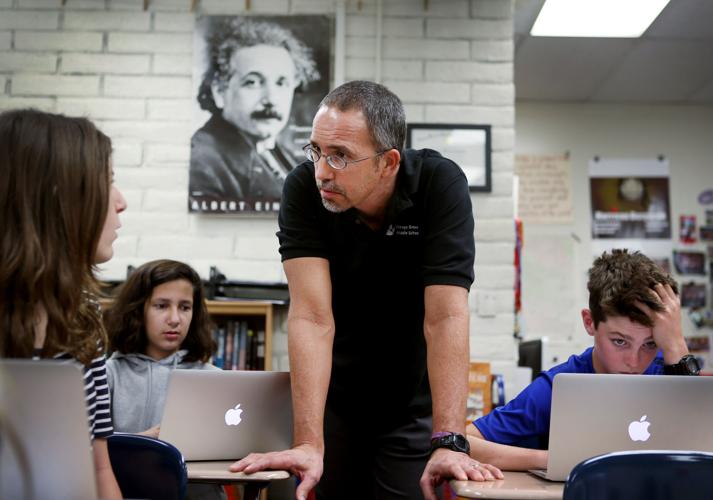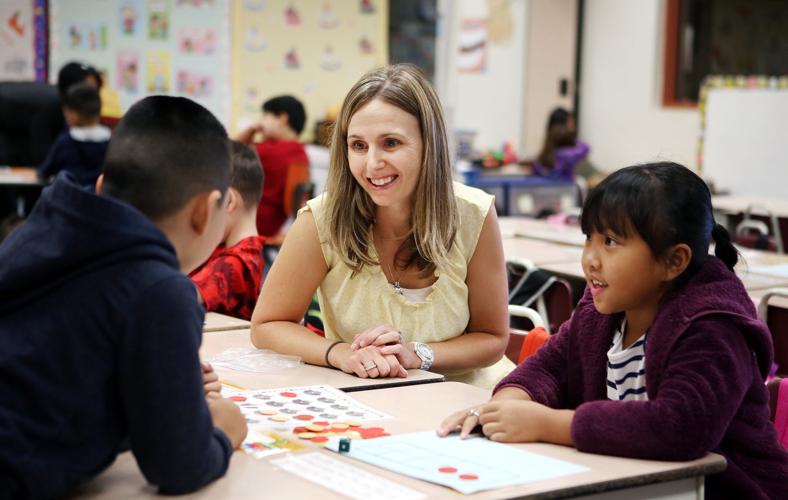Tucson has more than 130 national board-certified teachers — that’s the highest distinction a teacher can get — but not enough of them work in schools where kids need them most.
Research dating to the 1960s shows that poor and minority students benefit the most from high-quality teachers. TUSD — the area’s largest school district, with about 47,000 students — has the highest number of national board-certified teachers with 60, but most of the rest are concentrated in wealthier areas such as the Foothills and Oro Valley.
Five percent of Catalina Foothills teachers — 14 of them — have the top certification, exceeding both Arizona’s average of 2 percent and the national average of 3 percent. Amphitheater comes in next, with 29 national board-certified teachers among more than 800 teachers.
The districts with the lowest percentages are Vail and Sahuarita, which have many higher-income families, and Sunnyside, which has some of the area’s lowest-income neighborhoods.
Teachers who pursue certification tend to come from schools with policies and support systems to help them through the process, which is time-consuming and expensive, said Joe Doctor, chief operating officer for the National Board for Professional Teaching Standards, which administers the certification.
The board has worked to boost equity, giving teachers three years instead of one to complete the process, including written assessments, reports and videotaping teachers’ instruction. The organization also partners with the Bureau of Indian Education to get more teachers certified.
Board-certified teachers in the Tucson area typically earn annual stipends of $1,000 to $3,000. District officials say they support their teachers pursing national certification and they provide varying levels of training, but not all pay teachers’ fees, which can exceed $2,000.
Sunnyside does not pay for teachers’ certifications, but offers a $3,000 annual stipend, the highest among the nine districts in the Tucson area. Catalina Foothills reimburses teachers who are certified and have at least five years of teaching experience. Marana Unified offers two scholarships a year for teachers to get certified.
Research suggests that national board-certified teachers have positive impacts on kids. One study, by Arizona State University, said students in their classrooms made higher gains than peers with noncertified teachers.
The positive impact is compounded for minority and low-income students. A University of Washington study used data from North Carolina to determine that students who receive free or reduced-price lunch benefited the most from having a nationally certified teacher.
Love for learning
In Tracy Vincent’s first-grade classroom at Liberty Elementary School, a school in the Sunnyside district that’s federally designated as having high needs, 18 kids for whom English is a second language sat on a rainbow-colored mat one recent Thursday morning.
They cheered when their national board-certified teacher said they would play a math game, using buttons and dice to figure out different ways to get to the number 10. Even when they were allowed to play on their own, the first-graders stayed on task.
“I want my students to have a love for learning,” Vincent said. Her style is calm and patient. She rarely raises her voice and easily grabs her students’ attention by clapping five times.
Getting national board-certified seemed like the natural step, she said. “I wanted to make myself a better teacher.” But back then, the fee to get certified was about $3,000, which she couldn’t afford without help.
When Vincent received her certification in 2009, she got financial help from a teacher professional development organization that partners with Northern Arizona University.
Arizona has nearly 1,200 certified teachers, which is about 2 percent of the statewide teacher population. Most owe some level of thanks to the Arizona K12 Center for Professional Development, which not only helps with scholarships but also trains teachers wanting to pursue the certification.
The organization brings in interested teachers connects them with other candidates, said Kathy Wiebke, executive director. Teachers who decide to move forward are grouped into cohorts and given coaching and professional development.
About 800 teachers statewide are candidates for the certification process right now, she said. A growing contingent come from districts with high percentages of lower-income students, including the Phoenix Union High School District. Sunnyside currently has 24 candidates.
“If you can compensate teachers to do it, it always helps,” Wiebke said. “But that’s not the only thing. I think we need to honor it and communicate that it’s important.”
Other efforts also aim to get more Arizona teachers national board-certified. Master’s programs being developed at the university level include the certification process, said Beth Driscoll, director of educator preparation at the Arizona Department of Education.
“Best teacher ever”
Brian Bindschadler’s seventh-grade English class at Orange Grove Middle School was delving deep into the Holocaust on a recent Monday morning. The 30-year veteran teacher, who is national board-certified, has been with the Catalina Foothills district for more than two decades.
The students read two books about the Holocaust: “The Boy in the Striped Pajamas” by John Boyne and “Night” by Elie Wiesel. The latter was tough to read, students said. The horrid details were hard to swallow.
Using a smart board, Bindschadler flipped through images of fences surrounding the Auschwitz concentration camp, of abnormally thin people being crowded into tiny bunks, of maps showing the camp’s relative location in Poland.
“Imagine the scenes,” he told his students.
“I try to make things as experiential as possible,” he said later. “That’s more powerful than just reading.”
Benefits of a national board certification extend beyond money, teachers and administrators said. It shows in the way students engage and learn, as demonstrated by the concentration and engagement in Bindschadler’s classroom.
“Some classes, you pull out a textbook and you start reading, but he keeps us interested with interesting visuals and sometimes, sarcastic humor,” said Bailey Axen, one of his seventh-graders. He and classmate Ella Clemens describe Bindschadler as the “best teacher ever.”
“Everything he teaches relates to us in some way,” Clemens said. “He feels like someone who’s going to lead us into life.”





